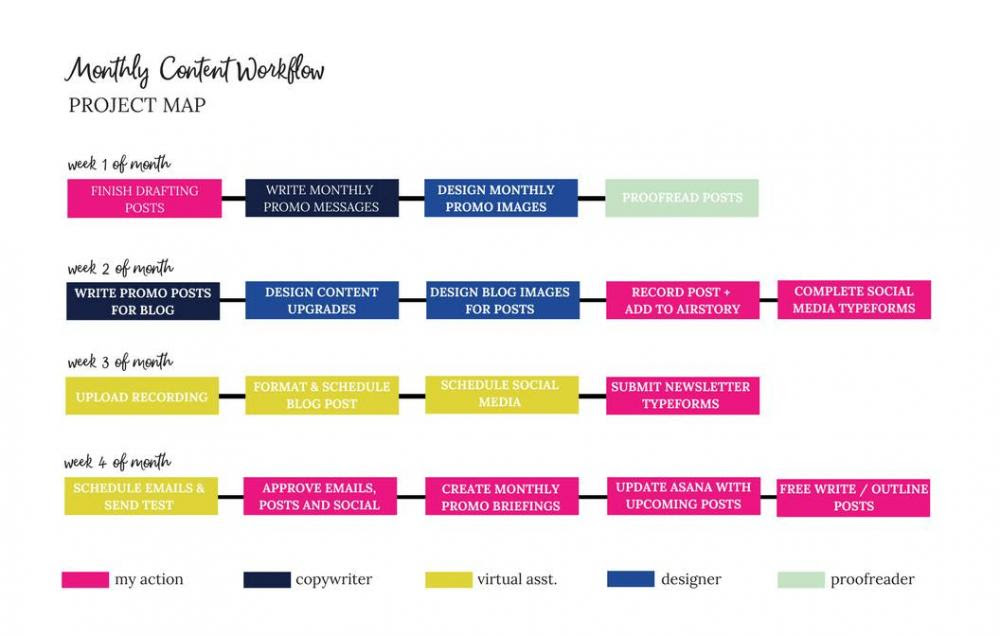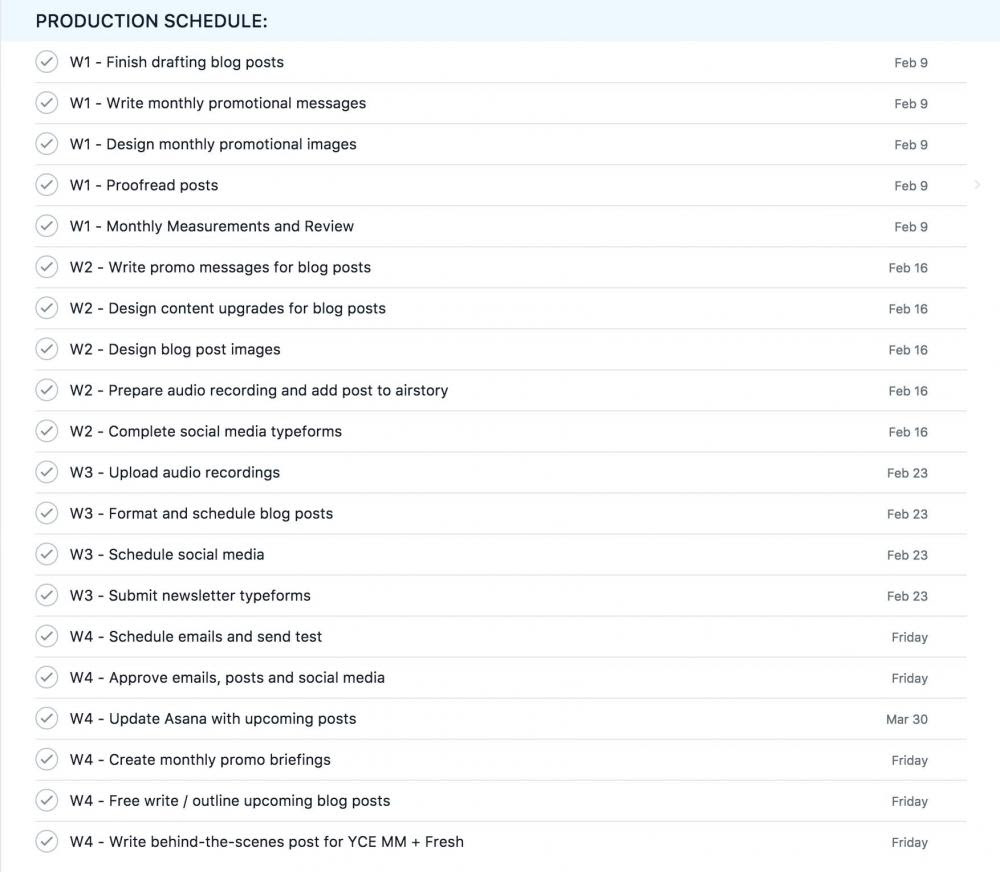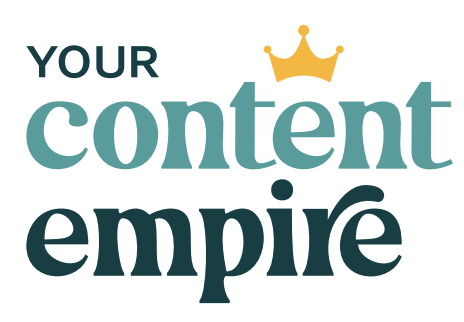You know you created your latest content plan with the best intentions (even before you figured out it's probably best to take a busy-proofing your content approach)
But when it comes to actually execute – it felt like everything in your life was conspiring to keep you from following through.
Family time – client work – the nagging feeling that you forgot to respond to something in that Facebook group.
I mean…if this embarrassing 2017 confession is any indication of how hard it can be for even a professional content creator with a team to keep up (from this post and excerpted below) then I don’t what is…
You’d think that as a content strategist who helps her clients manage successful content strategies and workflows that I’d have this all down for myself, right?
That’s not always the case. That shoemaker’s children’s shoe idiom strikes again.
Now I started 2017 off with a content strategy and editorial calendar that could basically run itself. My team and I were in a rhythm and our publishing schedule was like smooth jazz and a glass of red wine on Friday night – effortless.
However, mid-year, my husband and I took a first-anniversary slash honeymoon trip — and things quickly fell apart and getting back to our prior content-smoothness has been a bit bumpy.
I got so busy catching up with client work that my own stuff constantly fell to the bottom of my to-do list. You know that pit where things get lost and are never heard from again? (P.S. I’m so over being busy – I hate the feeling, I hate the word – I shake my head at the girl-me who was obsessed with color-coded planners and Ren Stevens – but that’s a story for another time.
So I knew from speaking to my clients and biz friends that this experience of feeling guilty about not keeping up with our (admittedly, sometimes) over-ambitious marketing plans was shared by most.
Here are the essentials to know:
- We all know how beneficial content is for our business, growth and visibility
- We’ve seen that when we show up content-wise, opportunities show up too
- But we create these content plans we’re excited about in the moment and when it comes to actually following them, that’s when things start to fall apart a little (or a lot)
- We feel like failures, super guilty and like we’re incapable of sticking to anything (maybe just me?)
And so I’ve spent most of 2018 wrapping my head around how to solve and that’s all been distilled down into a content workflow building process – whether you’re more of one-week-at-a-time creator or a batcher!
Introducing the Content Workflow
One of the best ways I’ve found to get consistent with your content is to take consistent action out of the equation.
So what if instead of having to create all of the content you need week in and week out, regardless of how busy you might be, you could create all your content in one week a month? A sprint versus sustained action.
You would have the rest of the month to focus completely and guilt-free on work you love doing in your business and other projects you want to move forward. To me, that feels like freedom.
Just as an example, here’s my own monthly content workflow:

My team’s workflow has us grouping like tasks together. I typically focus all of my monthly content towards a particular CTA or theme so this helps us stay “on topic” and more efficient, too (which makes me happy ‘cuz I'm footing the bill having my team help me!).
I also think of my content in terms of weekly content bundles where I'll be publishing and promoting one post plus choosing one additional promo for the week to focus on (like a guest spot, a freebie, a campaign, supporting a friend, etc.)
My monthly content prep really begins five weeks before content goes live (i.e. We start working in the last week of June to prep August’s content) …
In Week 4 of two months prior to publication >> I create the monthly promo calendar (what promos for what weeks), update Asana by copying of weekly content bundle template and putting in the details, and outlining and free writing (5-10 mins) for each upcoming blog post.
In Week 1 of the month prior >> In the margins of each weekday, I'll finish writing one blog post based on the outline/free writing I did the week prior. This takes me less than an hour, but usually around 20 minutes-ish? Then the posts are proofed, and all monthly promo graphics and messages are prepped.
In Week 2 of the month prior >> The social media posts and images for the blog posts are written (confession, I hate summarizing stuff and writing social posts, so outsourcing it is), then I finalize the social calendar (using my Typeform-Google Sheets-bulk scheduling system that takes less than an hour for all social but Pinterest). Ask me about that system in the Facebook group!
In Week 3 of the month prior >> My VA goes on a formatting, uploading and scheduling spree, and I write newsletters.
In Week 4 of the month prior (in addition to starting the next month's workflow) >>Emails are scheduled and I go on an approval spree.
Towards the end of this email, I'll also show you the Asana version of our workflow (although not the subtasks, cause that'd be a lot of pics, but these really get into the nitty-gritty of our step-by-step process).
Create Your Own Workflow
Batch or bespoke—what type of content process do you naturally lean towards? The efficient and organized batching approach, or the artisan bespoke process of one at a time; or maybe a combination of the two? In this lesson, we’ll be making that decision and building your workflow around it.
So, which sounds more like you? Efficiently creating content in batches you can get multiple weeks of content created, prepared and scheduled, allowing you to focus on other important areas in your business? Or carefully crafting each piece of content one at a time, so it gets your undivided attention and focus until it's done?
Start On The Solo Level
Regardless of which approach you choose, we have to start by teasing out the individual steps that go into each blog post. Let’s look at each stage of the process:
From Idea to Outline – What are all the steps that you take or want to take during this phase? Some examples—editorial planning, free writing, outlining.
From Outline to Draft – What are all the steps you’d like to take during this phase? This will depend on what format you choose—written, video or audio. If it's written, maybe that's writing the post, or researching it. If it's a podcast, maybe it's organizing the interview, preparing the questions, having the interview. For video, maybe it's your speaking notes and your recording.
From Draft to Final Version – What are the steps that go into your editing process? Your publishing preparation?
Then from Final Presentation to Publish – Maybe that's uploading, maybe that's your images, your content upgrades, formatting the blog post, scheduling and publishing it. Basically, everything that goes into just putting it out in the world.
Bring It To A Batching Level
If you’re going to just focus on doing your weekly content bundles one week at a time—you’re good. Tag me in the Facebook group and fill me in on your plan so I can cheer you on and provide feedback.
But if you’re going to take it to a batching level, like what my team does, here are the decisions that we have to make:
- How many posts are you going to be creating at the same time? Is it going to be monthly? All of your posts for monthly or quarterly, or other?
- What tasks will you do at the same time? Some ways to organize them … maybe by tool, so you're not opening a bunch of tools after the other and jumping back and forth. Or perhaps by stage of the process, and then maybe by dependencies. For example, maybe you need all the images before you can do all the scheduling; or maybe you need to interview someone before you edit it. You can organize and group those tasks together.
- When will these groups of tasks be done? What is the order of them? What is the week of the month?
- Then look at each task bundle and examine whether there are opportunities for templates and tools? Maybe a checklist, a Google template, template folders, canned email responses. In other words, what would make your job easier? What do you not want to not have to do more than once, beyond simply tweaking it? Like this monthly Asana checklist template that I copy over for every month’s prep …

Want the ultimate busy-proof strategy for your content:
This free on-demand workshop will help you create and design your first (completely busy-proofed) capsule content collection. Sign up here ↓
















